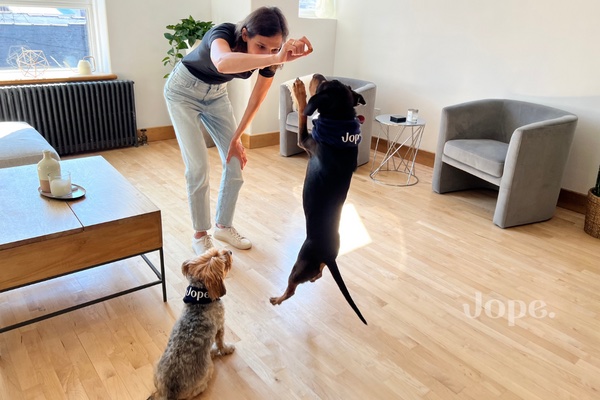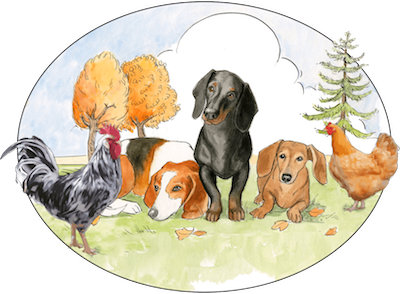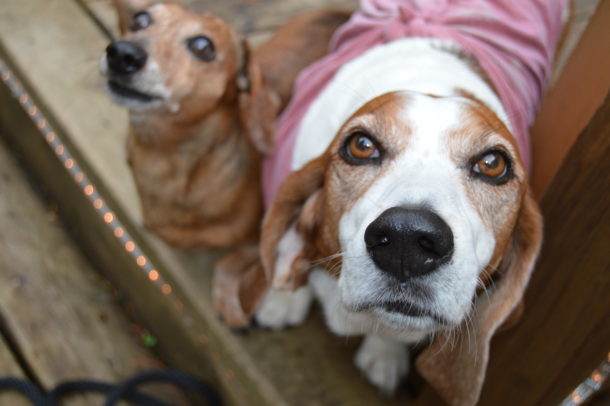A New Way to Help Your Senior Dog Feel Good
This is a guest article from a colleague with Jope and is being contributed by founders Christine Colamonico and Jeremy Adjovi Boco.
A common misconception about aging is that it’s a synonym for fatigue and decreased activity. But did you know that fatigue and reduced activity often show osteoarthritic pain?
In 2021, 15 million adult dogs in the U.S. suffered from osteoarthritis and senior dogs, eight years and up, are most affected. A study showed that 70% of dogs suffer from osteoarthritis and mobility issues at this age.
Now ask yourself if it’s normal for your senior dog to be less active and have trouble going upstairs. You’ve got it; the response is NO.
Fortunately, while you can’t cure osteoarthritis, you can find solutions to help your dog feels better, be more active and live a happier senior life!
How can you help your older dog feel young?
Different complementary solutions exist when it comes to helping your senior dog live their best life.
Veterinarians call it multimodal therapy, which combines different therapies for the best results. We will share here with you our favorite easy-to-implement multimodal solution:
Add vet-grade supplements to your dog’s diet
This is an easy change to implement in your dog’s routine that will go a long way to having them live a healthy life. Ideally, start giving veterinary-grade supplements when your dog is a puppy to support their growth. Then, continue when they are adults for a healthy lifestyle.
You can find many in the market, so choose wisely. First, prioritize supplements with UC-II, a different kind of collagen that is clinically and scientifically proven effective. Also, look for supplements with high doses of omega-3, specifically EPA and DHA, to help with joints, skin, hair, metabolism, and overall health.
Key take-home 1: look for a veterinary-grade supplement with UC-II and a high dose of omega-3.
Keep your senior dog active
You must remember that older dogs should always stay active!
However, you must adjust the activity time and intensity according to your dog’s overall health and capabilities. You want your dog to keep moving so the muscles stay strong and joints stay flexible. If your dog stops moving, joints will stiffen, and muscles will atrophy. As a result, a vicious circle will continue decreasing your dog’s activity and increasing their weight. Inactivity and obesity will reduce their quality of life and lifespan.
If you notice your dog struggling during normal daily activities, think about decreasing duration and intensity and increasing frequency. For example, replace one 45-minute run with two 20-minute fast walks.
Hydrotherapy is part of physiotherapy. It’s a powerful tool to keep your dog active while protecting the joints. Water resistance will decrease the pressure on the joints while strengthening the muscles. You can seek out dog rehabilitation centers or bring your dog to the beach or a lake.
Targeted exercises to reinforce your dog’s muscles are also a great way to keep their joints healthy. Ask your veterinarian for a visit, so they can show you how to perform specific exercises.
Key take home 2: keep your dog’s joints and muscles moving so your dog feels good!
Monitor and adjust your dog’s diet
Age decreases metabolism, so your dog will need fewer daily calories. Also, age will reduce their energy needs as they exercise in moderation.
So, you want to decrease the number of calories your dog eats daily.
You always want to ensure your dog gets a well-balanced, high-quality diet. Premium quality is essential for senior dogs as they need easy-to-digest nutrients to fuel them daily. Older dogs don’t have the exact needs as before.
- High-quality and easy-to-digest proteins are vital to protecting your dog’s kidneys while giving your senior dog the energy they need to remain active.
- A higher quantity of omega-3 will help your dog’s metabolism, and you’ll see visible results in the hair, skin, and joints.
- A high-fiber diet will allow good intestinal transit and ensure your dog stays healthy. Adding zucchini to your senior dog’s diet is a great way to bring fiber and have them feel fuller longer.
- An appropriate level of vitamins and minerals will help boost your dog’s well-being.
Ask your veterinarian for recommendations if you feel lost because of all the available options or if you want to cook homemade meals for your dog.
Key take-home 3: monitor your dog’s weight and switch to a high-quality protein and premium diet for a senior dog.
“Christy here, my dog Walter is obese and we’re trying hard to get the weight off. He’s ten and as a doxie we are working with a vet-board approved nutritionist on a fresh food diet to help with this issue. We’re also doing weekly hydrotherapy sessions. Whatever you decide to feed your dog, make sure you are measuring out the food for each meal and the calories match with what their daily intake needs to be. Also, remember to feed less if you used a lot of treats for training that day!”
What is UC-II?
Type II collagen is a different kind of collagen naturally present in humans and dogs.
UC-II is undenatured type II collagen and results from extracting the natural type II collagen from chicken cartilage through a delicate patented process. Therefore, type II collagen and UC-II have the same 3-D structure.
When your dog takes UC-II, Oral Tolerance allows the natural structure of UC-II to:
- enter the body through the intestines
- prevent the immune system from degrading joint cartilage
- help repair joint cartilage
Unlike other ingredients on the pet market, many scientific and clinical studies have objectively demonstrated the efficacy of UC-II. As a result, UC-II use is increasing in human medicine and veterinary specialists.
What are the benefits of UC-II for your dog?
Dogs of all ages can benefit from UC-II and, most of all, senior dogs.
According to the 20+ studies made on osteoarthritic dogs :
- UC-II provides a significant reduction in pain associated with osteoarthritis
- It helps dogs to be more active.
- It has shown similar results to NSAIDs (robenacoxib, which is like carprofen) in improving mobility for dogs with osteoarthritis.
- It increases the pressure dogs put on their joints and muscles, indicating decreased pain.
- It limits cartilage breakdown and helps maintain healthy joint metabolism.
Simply put, UC-II will help relieve senior dogs from joint discomfort and pain so they can live happier and healthier lives.
Is UC-II the same as chondroitin and glucosamine?
UC-II mode of action differs from chondroitin, glucosamine, CBD, MSM, and other ingredients you usually find in retail and online spaces.
Several studies have shown that UC-II is more effective than chondroitin and glucosamine in helping dogs with mobility and reducing pain and inflammation.
The most powerful study on UC-II is the “Plate-force study.” It used technology to show that arthritic dogs given UC-II could significantly increase the weight they put on their painful leg.
This study objectively proved that dogs with UC-II® felt better. In contrast, dogs with glucosamine and chondroitin showed no increase in the weight they put on their painful leg.
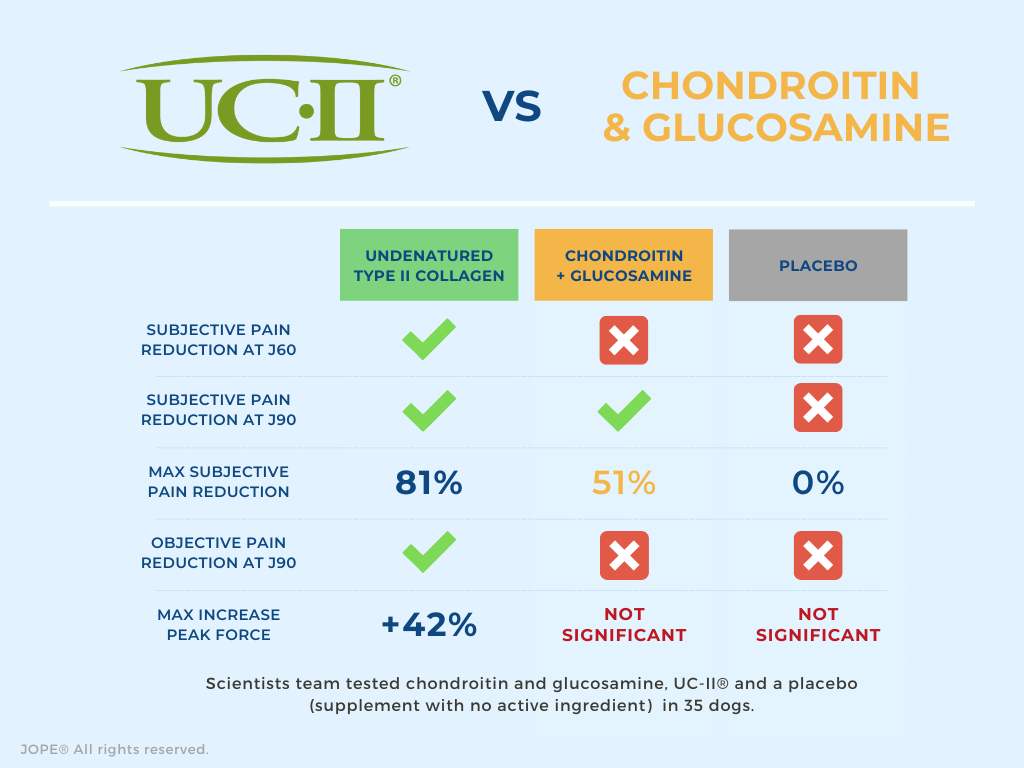
What else can you do to help your senior dog?
Ergotherapy
Your older dog might have difficulties with some actions, like getting in the trunk. Although you don’t want to avoid these situations altogether, you want to make them accessible.
Ergotherapy is the science of making actions possible and easier for your dog.
For the trunk example, you might use a ramp or a homemade “stair” to get in the trunk.
Physiotherapy
We mentioned hydrotherapy earlier, but physiotherapy includes many other activities. For example, your older dog could benefit from massages, therapeutic exercises, lasers, electrostimulation, or ultrasound therapy.
Visit your veterinarian for a senior evaluation visit and enquire about specialized structures they recommend.
The key takeaway is that older dogs should be energetic and that fatigue is often a sign of osteoarthritic pain.
Your senior dog will have healthier joints and live happier lives if you:
- Give them veterinary-grade hip and joint supplements with UC-II® and high doses of omega-3.
- Keep them active daily, with adequate exercises.
- Monitor their weight and give them a high-quality, balanced meal.
It’s always a fantastic idea to be proactive in your dog’s health. Book a visit with your veterinarian for a senior dog wellness assessment and enquire about diet changes and old dog-specific exercises. You will love to see your dog full of energy again!
***
These chews will be available to order on the PetJope website.
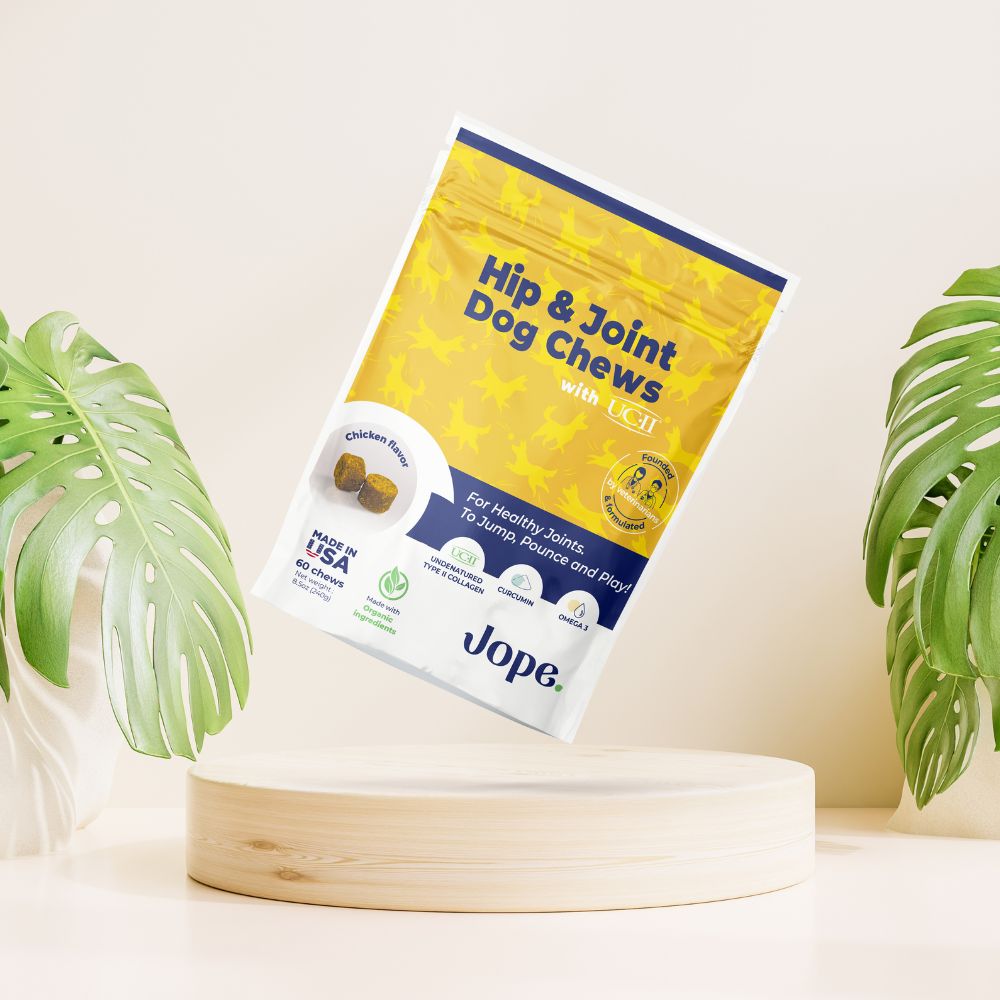
Resources:
Johnston SA. Osteoarthritis: Joint anatomy, physiology, and pathobiology. Vet Clin North Am: Small Anim Pract 1997;27:699-723.
Gupta, R C et al. “Comparative therapeutic efficacy and safety of type-II collagen (UC-II®), glucosamine and chondroitin in arthritic dogs: pain evaluation by ground force plate.” Journal of animal physiology and animal nutrition vol. 96,5 (2012): 770-7.
Stabile, Marzia et al. “Evaluation of the Effects of Undenatured Type II Collagen (UC-I®I) as Compared to Robenacoxib on the Mobility Impairment Induced by Osteoarthritis in Dogs.” Veterinary sciences vol. 6,3 72. 4 Sep. 2019, doi:10.3390/vetsci6030072
